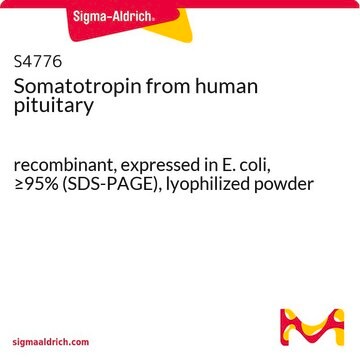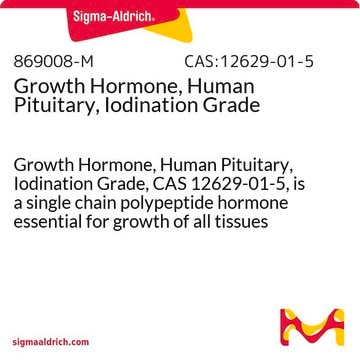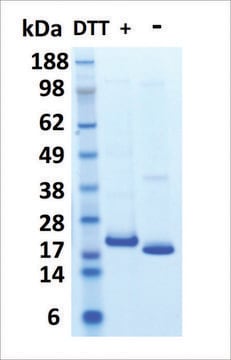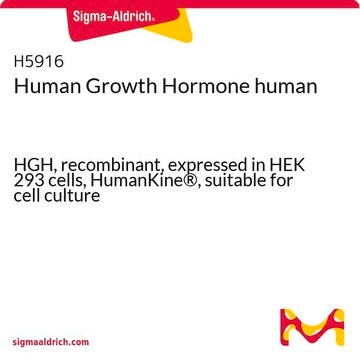추천 제품
일반 설명
GHBP is a transmembrane receptor for growth hormone. Binding of growth hormone to the receptor leads to receptor dimerization and the activation of an intra- and intercellular signal transduction pathway leading to growth. A common alternate allele of this gene, called GHRd3, lacks exon three and has been well-characterized. Mutations in this gene have been associated with Laron syndrome, also known as the growth hormone insensitivity syndrome (GHIS), a disorder characterized by short stature. Human Recombinant GHBP expressed from E. coli is a single, non-glycosylated, polypeptide chain containing 237 amino acids and having a molecular mass of 28.1 kDa. GHBP is purified by proprietary chromatographic techniques.
The gene encoding growth hormone receptor (GHR or GHBP) is localized on human chromosome 5p13.1-p12, with nine exons.[1][2] It possesses a cytoplasmic and an extracellular domain for protein binding.[2]
The gene encoding growth hormone receptor (GHR or GHBP) is localized on human chromosome 5p13.1-p12, with nine exons.[1][2] It possesses a cytoplasmic and an extracellular domain for protein binding.[2]
물리적 형태
GHBP was lyophilized from a concentrated (1 mg/ml) solution with 0.0045 mM NaHCO3.
재구성
Centrifuge the vial prior to opening. Avoid freeze-thaw cycles.
Reconstitute in sterile dH2O not less than 100 μg/ml. This solution can then be diluted into other aqueous buffers.
가장 최신 버전 중 하나를 선택하세요:
New molecular mechanisms of GH resistance
European Journal of Endocrinology, 151(1) (2004)
Growth hormone receptor (GHR) gene polymorphism and Prader--Willi syndrome.
Butler M G, et al.
American Journal of Medical Genetics, 161(7), 1647-1653 (2013)
De-Gang Song et al.
Oncotarget, 6(25), 21533-21546 (2015-06-24)
Chimeric antigen receptors (CARs) can redirect T cells against antigen-expressing tumors in an HLA-independent manner. To date, various CARs have been constructed using mouse single chain antibody variable fragments (scFvs) of high affinity that are immunogenic in humans and have
Eric L Carter et al.
The Journal of biological chemistry, 291(5), 2196-2222 (2015-12-17)
Rev-erbα and Rev-erbβ are heme-binding nuclear receptors (NR) that repress the transcription of genes involved in regulating metabolism, inflammation, and the circadian clock. Previous gene expression and co-immunoprecipitation studies led to a model in which heme binding to Rev-erbα recruits
활성 필터
자사의 과학자팀은 생명 과학, 재료 과학, 화학 합성, 크로마토그래피, 분석 및 기타 많은 영역을 포함한 모든 과학 분야에 경험이 있습니다..
고객지원팀으로 연락바랍니다.








